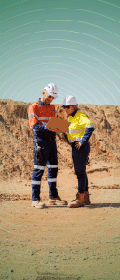 Rio Tinto is pushing ahead with its industry-leading Mine of the FutureTM programme, with plans for the development and testing of new technologies in underground tunnelling and mineral recovery. Rio Tinto Head of Innovation John McGagh said “Rio Tinto is head and shoulders above the rest of the industry in our technology and innovation programmes. Mine of the Future is becoming a reality today, with full-scale rollout of automation of mine equipment and large-scale tests of tunnelling, mineral recovery and exploration technologies. Being ahead of the pack gives Rio Tinto a competitive edge in the global mining landscape by generating more efficient and cost-competitive methods of finding, extracting and processing mineral resources and providing new, engaging and diverse employment opportunities.”
Rio Tinto is pushing ahead with its industry-leading Mine of the FutureTM programme, with plans for the development and testing of new technologies in underground tunnelling and mineral recovery. Rio Tinto Head of Innovation John McGagh said “Rio Tinto is head and shoulders above the rest of the industry in our technology and innovation programmes. Mine of the Future is becoming a reality today, with full-scale rollout of automation of mine equipment and large-scale tests of tunnelling, mineral recovery and exploration technologies. Being ahead of the pack gives Rio Tinto a competitive edge in the global mining landscape by generating more efficient and cost-competitive methods of finding, extracting and processing mineral resources and providing new, engaging and diverse employment opportunities.”
Rio Tinto is expanding trials of new shaft and tunnel boring systems, aimed at significantly reducing the time taken to excavate underground, with the announcement of a second tunnel boring trial. Rio Tinto is working in partnership with Atlas Copco on the trial, which will start in 2013 at Rio Tinto’s Kennecott Utah Copper (KUC) mine in Salt Lake City. The Atlas Copco Tunnel Boring System at KUC is expected to allow Rio Tinto to tunnel more than 10 m a day – nearly twice the rate of conventional methods.
The first tunnel boring trial, run in partnership with Aker Wirth, will begin this year at the Northparkes copper and gold mine in New South Wales. Locations are currently being considered for a shaft boring system trial.
McGagh said “More mining is moving underground as deeper ore bodies are identified and open pits come to the end of their lives. Constructing underground mines can be technically challenging, expensive and a slow process. These trials mean we can test the technology to allow us to mine deeper and more safely, with the potential benefits of greater efficiency and speed of underground mine construction which would increase the value of the projects.”
Rio Tinto is also working on ways of improving rates of ore recovery from mature and complex deposits. These will be discussed in detail in the magazine in the April issue’s processing focus article.
Work is continuing on the development of the VK1airborne gravity gradiometer, an exploration tool with the potential to assist Rio Tinto find future tier one ore bodies. The system detects small changes in the earth’s gravitational field which can indicate the presence of mineral deposits.
The first complete system was initially flown in August 2010, and undertook several test flights throughout 2011. A second improved system was constructed in 2011 and has just commenced flight testing near Perth. Once the system approaches target performance, the 2012 plan will extend the test flight programme to the Pilbara.









